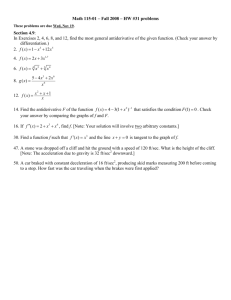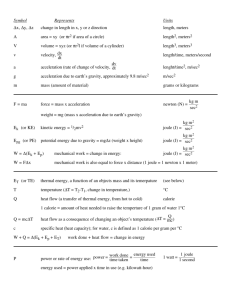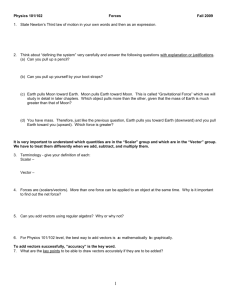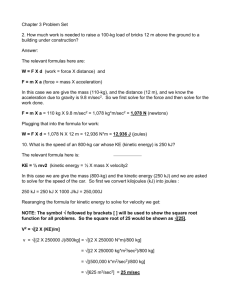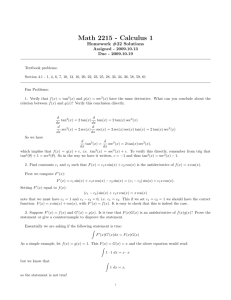Practical Considerations for Low Noise Measurement, J.M.W.
advertisement
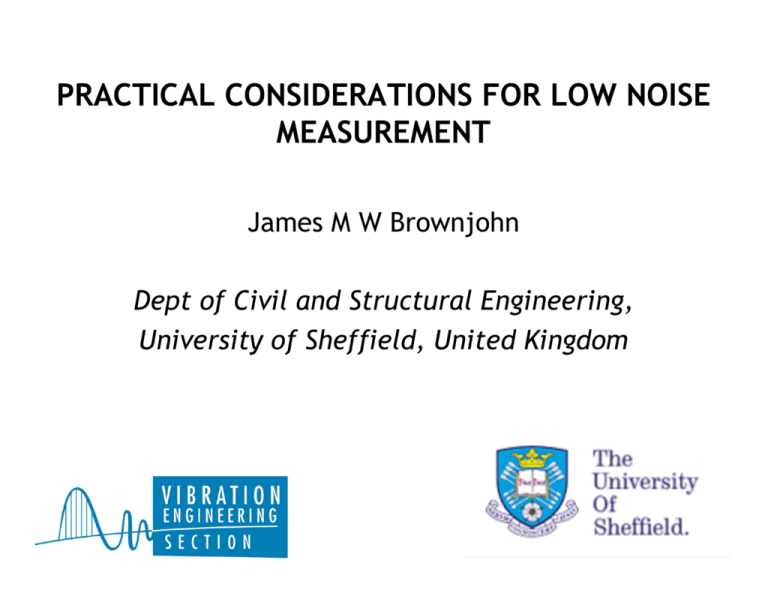
PRACTICAL CONSIDERATIONS FOR LOW NOISE
MEASUREMENT
James M W Brownjohn
Dept of Civil and Structural Engineering,
University of Sheffield, United Kingdom
CONTENTS
• Motivation: extreme structure performance
requirements
• About power spectral densities and mean squares
• Representations of signal levels and performance
requirements
• Some sensor specifications and measured
performance
• miscellaneous
–
–
–
–
–
–
Measurement chain and bits
Resolving a harmonic
A fundamental limitation
Ultimate noise floor evaluation
Sensor mounting
Cabling
Why low noise measurements?
• When (vibration) signals
are extremely weak
• When they are very low
frequencies, <1Hz
• Usually ground-borne
transmission
• In High-specification
environments
• Labs and fabs are
requiring ever ‘quieter’
environments to operate
Some structures for which low-level (ground-borne)
vibration may govern design
-biotech facility
-flat panel plant
-synchrotron
-laser facility
Super low frequency structure: Humber Bridge
VL1=0.05Hz=0.06Hz
Some structure performance requirements:
• Synchrotron targeting magnets with dynamic stability
requirements down to 10-12m (pico-metre)
• Laser alignment systems requiring relative positional
stability to <0.5 micron
• Microchip plants with generic performance
requirements rated as VC-E or VC-D
(<6.25μm/sec and 3μm/sec as 1/3rd octave RMS)
• Gravitational wave detectors with test mass vibration
levels < 10-12g
How to interpret these measurements and match them
with instrumentation limitations so that
Instrument ‘resolution’ << site vibration levels
Do we have signal or do we have noise?
Typical vibration levels at super-quiet sites
Why use PSD representation?
Area under PSD ‘curve’ is mean square MS (power),
{Area under (Time history)2}/T is mean square MS
PSD derived from FFT line amplitude A by PSD(f)=A2(f)/2df
∫
fmax
0
∫
fmax
0
PSD ( f )df
1 T 2
=MS =
(
)
V
t
dt
∫
T 0
PSD ( f )df = RMS =
1 T 2
V (t ) dt
∫
T 0
Mains voltage =240V RMS actually 340V amplitude, power=V2/R
we can equate mean square
in time and frequency
domains.
0.8
0.6
Mean square=0.46665
V2
1 T 2
mean square = ∫ V (t )dt →
T 0
1
0.4
0.2
V
0.5
0
0
0
2
4
6
time /seconds
8
10
-0.5
0.07
1
2
3
4
5
6
seconds
7
8
9
10
0.06
0.2
FFT amplitudes
ASD
V/Hz0.5
0.1
0.05
PSD V2/Hz
V
0.15
0.05
0
1
2
3
4
5
Hz
6
7
8
9
10
0.04
Area=0.46665
0.03
0.02
0.01
mean square = ∫
fmax
0
PSD ( f )df →
0
0
2
4
6
frequency /Hz
8
10
velocity PSD
10
0
2
(μm/sec) /Hz
Low level signals for instruments
often given as PSDs of
displacement (d), velocity (v) or
acceleration (a) on logarithmic
axes. Note:
PSD(d) x ω2=PSD(v)
PSD(v) x ω2=PSD(a)
10
-5
Less common sensor form
-velocity
10
-10
10
-1
10
0
10
1
10
2
f /Hz
acceleration PSD
displacement PSD
10
10
0
2 2
(μm/sec ) /Hz
0
10
2
(μm) /Hz
10
Most common structure
specification
10
-5
10
-10
10
-1
10
0
10
f /Hz
1
10
2
Most common sensor form
-acceleration
-5
-10
10
-1
10
0
10
f /Hz
1
10
2
ndof_chirp
10
4
2
0
2
4
6
8
10
f/Hz
ndof_chirp
ch1 log10(μ m.sec )
ch 1 (μm/sec)
6
-1
• An alternate to PSD is 1/3rd
Octave spectra
• 1/3rd octave spectrum shows
RMS in consecutive bands in
geometric progression
2 : 2.67 : 3.3 : 4 : 4.67 etc.
• Each band RMS is derived
from sum of FFT2/2 lines in a
narrowband, width α centre
frequency
• -formerly done by analog
analysers using filter banks …
FFT line
(amplitude)
spectrum
8
2
1/3rd octave
spectrum
1
0
1
log (F/Hz)
10
0.7
…time domain filtering equates to
limiting the integration range in
frequency domain
0.6
0.5
V2
0.4
1 T 2
mean square = ∫ V (t )dt →
T 0
0.3
0.2
0.1
V
0.5
Mean square=0.03845
0
0
0
2
4
6
time /seconds
8
10
-0.5
0.07
1
2
3
4
5
6
seconds
7
8
9
10
0.06
0.2
0.05
FFT amplitudes
0.1
PSD V2/Hz
V
0.15
0.05
0
1
2
3
4
5
Hz
mean square = ∫
fmax
fmin
6
7
8
9
10
PSD ( f )df →
0.04
Area=0.03845
0.03
0.02
0.01
0
0
2
4
6
frequency /Hz
8
10
Generic vibration
criteria now available
down to VC-G
specifying velocity
RMS levels in 1/3rd
octave bands
How can we use sensor specification to evaluate low
noise, low frequency measurement capability?
• Endevco 7754-1000 (IEPE):
10μg RMS (typical) from 0.1-100Hz or
0.5μg/√Hz
• Honeywell QA 700 (servo):
Resolution/Threshold <1μg max
• Kistler 8330A accelerometer (servo):
1.3μg resolution <10Hz
• Guralp CMG-3ESPD (seismometer):
below Peterson ‘New low Noise Model’
between 40s and 16Hz
ASD Noise levels in theory and practice
(see IMACXXV): Endevco vs QA 700
• Endevco quoted: 0.5μg/√Hz Æ 5μm/sec2/√Hz
• Actual from quiet site
≥ 5μm/sec2/√Hz
• Low frequency drift makes them unsuitable for low
frequency velocity measurement (by integration)
• QA 700 quoted: 1μg Æ
10μm/sec2
• Actual from quiet site
1-5μm/sec2/√Hz
• 1μm/sec2/√Hz Æ 100(μm/sec2)2 = 10μm/sec2=1μg
in 100Hz band
• 5μm/sec2/√Hz Æ 2500(μm/sec2)2 = 50μm/sec2=5μg
Measurements at very quiet site, consecutively:
Endevco: –low freq thermal drift
QA 700: high freq noise
FAB1A_1
FAB1_2
1
1
0.5
ch 1 (mm/sec2)
ch 1 (mm/sec2)
0.5
0
-0.5
-1
-1.5
1040
0
-0.5
-1
1050
1060
1070
1080
seconds
1090
1100
-1.5
400
1110
410
420
430
450
460
470
Apow: ch1
100
120
80
100
80
60
μ m/sec1.5
μ m/sec1.5
Apow: ch1
440
seconds
40
60
40
20
20
0
10
20
30
40
50
f /Hz
60
70
80
90
100
0
10
20
30
40
50
f /Hz
60
70
80
90
100
With filtering and trend-line:
QA700 0.5Hz-30Hz signal in a quiet lab
ch 2 (μ m/sec2)
ch 1 (μ m/sec2)
test_01_dsa_noise
100
0
-100
100
0
-100
0
500
1000
seconds
1500
2000
test_01_dsa_noise Apow: ch1
5
0
Apow: ch2
10
μ m/sec1.5
Using Coherence to
look for pure noise
μ m/sec1.5
10
5
0
ASD shows about
3μm/sec1.5 before filter
roll off.
Close to zero coherence
where 3μm/sec1.5
obtained
0.7
5
test_01_dsa_noise
vs ch1
10
15 coh: ch220
f /Hz
25
30
25
30
0.6
0.5
0.4
0.3
0.2
0.1
0
5
10
15
f /Hz
20
Low frequency QA triaxial noise floor limits as microns
Æ(1μm/sec2)2/Hz = 1μm/sec2/√Hz
channel 1
0
2
μm /Hz
10
-10
10
channel 2
0
2
μm /Hz
10
-10
10
channel 3
0
2
μm /Hz
10
-10
10
-1
10
0
1
10
10
f/Hz
2
10
Even QAs are limited for ultra-low level
measurements
• Measurements at DLS
compared QA 700
with Guralp
seismometer
(commonly used in
GSN stations)
velocity spectrum
Accelerometer/seismometer performance difference is clear:
For low frequencies the seismometer is best choice
2
10
0
(μm/sec)2/Hz
10
-2
10
-4
10
Guralp CMG-3ESPD
Q-Flex QA700
0
10
1
10
f /Hz
2
10
3
2
ch1 log10(μ m/sec)
1/3rd octave velocity
spectra summarise
comparison for best ‘quiet
site’ measurements
1
0
-1
3
3
2
2
ch4 log10(μ m/sec)
ch1 log10(μ m/sec)
-2
1
0
QA-700
-1
-2
Endevco
0
1
log10(f /Hz)
1
0
Guralp
-1
0
1
log10(f /Hz)
2
-2
0
1
log10(f /Hz)
2
Noise in acquisition chain?
SETUP9_4
0.03
• QA system with
disconnected
accelerometers
• (NI ‘E-series’ 16-bit card)
at ±5V range
ch 8 (mm/sec2)
0.02
0.01
0
-0.01
-0.02
-0.03
0
500
1000
1500
seconds
2000
2500
SETUP9_4 Apow: ch8
7
5
μ m/sec1.5
• Equivalent noise is
< 1μm/sec2/√Hz
6
4
3
2
1
0
5
10
15
f /Hz
20
How many bits do you need?
1
0.8
0.6
0.4
0.2
0
-0.2
-0.4
-0.6
-0.8
-1
0
0.1
0.2
0.3
0.4
0.5
time/seconds
0.6
0.7
0.8
0.9
1
Above shows 4 bits in ±1V range.
To record a signal up to 5 milli-g using sensor with threshold
1μg needs just more than 12 usable bits (4096 bit levels).
16 bits (65536 levels) gets you up to 0.065g. If you are looking
to resolve the μgs you’ll probably not be experiencing more
than 5%g!
Do you really need 24 bits? –soon we won’t need to decide
Resolution of 1μg (10μm/sec2) 10Hz harmonic
vs noise of 5μg (50μm/sec2) (typical QA7x0)
Not visible in signal
clear in PSD: at df=0.01Hz
->70.7μm/sec2/√Hz
50 micron/sec2 noise
50 micron/sec2 noise μ m/sec2
15
μ m/sec1.5
200
0
-200
μ m/sec1.5
0
μ m/sec1.5
0
85
86
seconds
total
100
200
84
50
0
total μ m/sec2
83
1 micro-g harmonic
100
20
-200
5
0
1 micro-g harmonic μ m/sec2
-20
10
87
88
50
0
20
40
60
f /Hz
80
100
120
Is there a fundamental limit to lowest levels of
detectable vibration?
3
1
μ m/sec
• Velocity signals
inside super-quiet
site
2
0
-1
-2
-3
480
500
520
seconds
540
560
480
500
520
seconds
540
560
2
• Corresponding
displacements
μm
1
0
-1
-2
Hump between 0.1 and 0.2Hz is real
signal is vibrations of earths crust
(due to coastal waves)
Proves futility of measuring absolute displacements less
than 1micron
(μm)2/Hz
10
10
10
0
-5
-10
10
-1
10
0
10
f /Hz
1
10
2
How to check
sensor noise
levels?
Use sensory
deprivation system,
like this folded
pendulum
Sensor mounting
• Seismometer guidelines
specify sitting sensor on
adjustable feet
• No need to glue/fix
• Mounting surface, feet and
sensor form mechanical
system: keep it stiff
• Shield from air
currents/temperature
changes
Cabling
ICP sensors with microdot cables in
hot/humid environment
(Singapore) were mostly too noisy
to use on this bridge
Pay attention to cabling and connectors
• Force balance accelerometers send current to generate
Voltage across load resistor. Cable length can be kilometres
with no noticeable added noise
XLR type connectors, shielded cable reduce
problems
Conclusions
•
•
•
•
Know your sensors
Translate the specification to English by experiment
Know the sensor limitations with your own setup
Make sure you have dynamic ‘room’ between site noise
and sensor noise
• Cabling is still a killer
• You can’t escape wobbles of the earth’s crust
